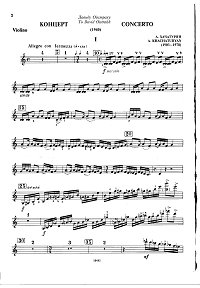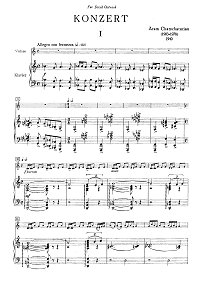Khachaturian - Violin concerto
|
Khachaturian - Violin concerto. You can download the PDF sheet music Khachaturian - Violin concerto on this page. Aram Khachaturian's Violin Concerto in D minor was completed in 1940 and dedicated to the Russian violinist David Oistrakh, who premièred the concerto in Moscow on September 16, 1940. Oistrakh advised Khachaturian on the composition of the solo part and also wrote his own cadenza that markedly differs from the one originally composed by Khachaturian. The concerto was initially well received and awarded the Stalin Prize for arts in 1941. The work became a staple of the 20th century violin repertoire, and maintains its popularity into the 21st century. By choosing the key of D major, Khachaturian associates himself with the tradition of the great "classical" violin concertos — Beethoven, Brahms, Tchaikovsky and Glazunov. He consciously remains faithful to the traditional model also in his retention of a three-movement plan comprising an Allegro in sonata form, a lyrical slow movement and a dance-like rondo. The novel element, characteristic for Khachaturian, is the injection of material derived from Caucasian folk-music.
To download PDF, click the "Download PDF" button below the appropriate sheet music image.
To view the first page of Khachaturian - Violin concerto click the music sheet image.
|
| PDF format sheet music |
|
|
|
Instrument part: 35 pages. 1753 K
|
Piano part: 62 pages. 3563 K
|
 |
 |
|
|
| Download PDF (14.99
€) |
Download PDF (14.99
€) |
|
|
The Violin Concerto was the second of three concertos Khachaturian wrote for the individual members of a renowned Soviet piano trio that performed together from 1941 until 1963. The others were: the Piano Concerto for Lev Oborin (1936); and the Cello Concerto for Sviatoslav Knushevitsky (1946).
The first movement begins with a strongly marked theme reminiscent of Armenian folk-dances performed by men. The soloist immediately passes over to virtuosic figuration, but without losing the harsh, energetic character of the theme. A strong contrast is offered by the second theme, an expressive cantilena that likewise finds inspiration in national folk-music. Scale-passages and violinistic repeated figures, which can be reproduced convincingly on the flute, dominate the development section. The recapitulation brings back the first theme in abbreviated guise, and it is the second theme, now embroidered with triplets, that forms the lyrical climax of the movement.
All the magnificence of oriental melody and ornamentation are lavished on the Andante sostenuto, whose elegiac theme circling around a central key — a variant of the lyrical theme in the first movement — is decorated increasingly elaborately with appoggiaturas and arabesques. A new version of this theme, made more lively so that it resembles a dance, forms the middle section of the finale. The main theme of this movement imitates the "Lesginka", a wild Caucasian dance for men that has enjoyed great favour in the Russian art-music tradition.
|
|